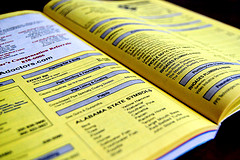Regular reader Leon is just dialing it in with his hugelkultur experiment. He posted something cool in the comments section of a post I did a while back. I decided I needed to re-post it – because it’s brilliant:
“(…) That reminds me of another experiment I did last summer – I dug a hole with a posthole digger and stuffed it with rolled up phone books and catalogues. Then I covered it with a bit of sand and planted cow-peas on the top of that hole and a few control holes (with nothing but sand inside). No irrigation except for the rain. Plants on top of yellow pages were about 3 times as big and lived a whole month longer into the Fall and almost made it to seed (I planted them pretty late, July, I think). I take it means that here water is the main limiting factor (and it’s great to finally have a way to use them stupid catalogues for
something good :)”
Three times as big. That’s success!
These are the kind of things you do when you color outside the lines and don’t live your life by the “conventional wisdom.” These “eureka” moments make gardening exciting. We’re interacting with a dynamic, living world and sometimes something as weird as burying a phone book can cause very productive results.
I wonder if specific sections of the phone book would be more conducive to plant growth? For example, if you planted an invasive plant over the “legal” section of the Yellow pages, would it die from fear?
Heh.
UPDATE On The Phone Book Hugelkultur Experiment:
“Checked on the phone books in March of 2013 – they’re pretty much still there and wet as a sponge (much more so than the sand around). New plants (chaya) planted on the top. At another location a newly planted poplar tree planted next to a “yellow pages hole” survived my 3 week absence (and lack of watering) but the one further away did not. I’m running out of catalogs and such – now I’m sticking them everywhere I plant anything!”
This is similar to the melon pit idea I write about in my book. Hugelkultur is just hitting mainstream – let’s build on it with millions of experiments!



7 comments
Thanks for spreading the knowledge! Just to clarify – it's not my idea – I've either heard or read about that somewhere.
The fact that you actually tried it – and posted on it – is excellent. Our sand needs all the help it can get.
My latest experiment has been to transplant some forest soil–in intact chunks, into a test garden bed. I took my lawn tractor with a trailer into the adjoining woods, found a few old rotted felled oak trees, and underneath them was some of the darkest, nicely-structured soil you can imagine.
I took one trailer load (about 3 wheelbarrows) of soil mixed with rotted wood and made 5 small raised beds, just by mounding it over some pine mulch and compost, about 6" deep. I can water these beds briefly every other day, and they stay nice and damp, even in full sun. So far, peas, beans, broccoli, cauliflower, kale and spinach are seeding nicely in it. Will keep informed on progress.
You've been busy. I didn't know you'd done that much. I need to stop by and see the homestead before too long. Maybe we could double-dig a new bed or something.
Sounds great, just need to wait for a little more dust to settle in my current family situation.
I really like the idea that soil can be cultivated passively, and I like the idea that every environment has its own strengths to be exploited. Central FL is bursting with oak trees, most of them having little value for carpentry or manufacturing, being too heavy, tough, twisted, and fibrous. But I have noticed when they decompose, they leave a most amazing soil residue (much better than pine). My neighbor left a pile of small oak logs on her driveway for a year or so, and when I went to move them for her, I found a layer about 3-4" deep of black, black compost full of earthworms. That's just from one year, and no work involved. Imagine the potential of strategic long-term oak soil cultivation.
Update:
Checked on the phone books in March of 2013 – they're pretty much still there and wet as a sponge (much more so than the sand around). New plants (chaya) planted on the top. At another location a newly planted poplar tree planted next to a "yellow pages hole" survived my 3 week absence (and lack of watering) but the one further away did not. I'm running out of catalogs and such – now I'm sticking them everywhere I plant anything!
Nice!
Comments are closed.